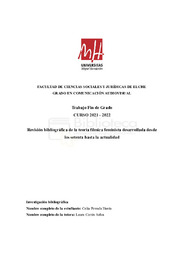Por favor, use este identificador para citar o enlazar este ítem:
https://hdl.handle.net/11000/28067Registro completo de metadatos
| Campo DC | Valor | Lengua/Idioma |
|---|---|---|
| dc.contributor.advisor | Cortés Selva, Laura | - |
| dc.contributor.author | Poveda Iñesta, Celia | - |
| dc.contributor.other | Departamentos de la UMH::Ciencias Sociales y Humanas | es_ES |
| dc.date.accessioned | 2022-10-27T10:06:17Z | - |
| dc.date.available | 2022-10-27T10:06:17Z | - |
| dc.date.created | 2022-06-13 | - |
| dc.identifier.uri | https://hdl.handle.net/11000/28067 | - |
| dc.description.abstract | La presencia de la mujer en el cine tanto delante como detrás de las cámaras lleva siendo un tema de ferviente debate desde la década de los setenta. Desde ese momento, se han creado una gran cantidad de teorías que tratan de explicar el fenómeno de la sexualización y cosificación de la mujer en los relatos audiovisuales, así como el rol de la mujer en la industria cinematográfica, destacando su ausencia en cargos de responsabilidad. Conceptos como el de mirada masculina o femenina continúan debatiéndose en la actualidad buscando una definición que consiga abarcar la complejidad del fenómeno. De ahí que el estudio de la teoría fílmica feminista siga siendo relevante a día de hoy: primero, para seguir constuyendo un marco teórico que incluya consiga englobar la totalidad de los conceptos que surgen y que tratan de ajustarse a las diferentes realidades existentes. Y segundo, porque también ayuda a plantear debates sobre la importancia de la mujer detrás de las cámaras y el papel que puede desempeñar en cargos de liderazgo como el de dirección. Por lo tanto, el objetivo de esta investigación es realizar una revisión bibliográfica sobre las principales teorías fílmicas feministas para conocer el estado actual del debate. Asimismo, se plantea la cuestión de si la presencia de una mujer como directora de cine contribuye o no a crear nuevos puntos de vista. | es_ES |
| dc.description.abstract | The presence of women in cinema, both in front of and behind the cameras, has been a subject of debate since the 70s. Since then, a large number of theories have been trying to explain the phenomenon of sexualization and objectification of women’s bodies in cinematic stories, as well as the role of women in the film industry, highlighting their absence in positions of responsibility. Concepts such as the male or female gaze continue to be debated today, seeking a definition that manages to encompass the complexity of these concepts. Hence, the study of feminist film theory continues to be relevant today: first, because it is necessary to create a clear and defined theoretical framework for all those concepts that have emerged over the years. And second, because it also helps to raise debates about the importance of women behind the scenes and the role they can play in positions such as management. Going through the different authors will help to establish common points between all the theories, and to raise the question of whether the presence of a woman directing the camera contributes or not to creating new points of view. | es_ES |
| dc.format | application/pdf | es_ES |
| dc.format.extent | 36 | es_ES |
| dc.language.iso | spa | es_ES |
| dc.publisher | Universidad Miguel Hernández de Elche | es_ES |
| dc.rights | info:eu-repo/semantics/openAccess | es_ES |
| dc.rights | Attribution-NonCommercial-NoDerivatives 4.0 Internacional | * |
| dc.rights.uri | http://creativecommons.org/licenses/by-nc-nd/4.0/ | * |
| dc.subject | fílmica feminista | es_ES |
| dc.subject | directoras cinematográficas | es_ES |
| dc.subject | mirada | es_ES |
| dc.subject | género | es_ES |
| dc.subject.other | CDU::3 - Ciencias sociales::31 - Demografía. Sociología. Estadística::316 - Sociología. Comunicación | es_ES |
| dc.title | Revisión bibliográfica de la teoría fílmica feminista desarrollada desde los setenta hasta la actualidad | es_ES |
| dc.type | info:eu-repo/semantics/bachelorThesis | es_ES |

Ver/Abrir:
TFG-Poveda Iñesta, Celia.pdf
580,4 kB
Adobe PDF
Compartir:
 La licencia se describe como: Atribución-NonComercial-NoDerivada 4.0 Internacional.
La licencia se describe como: Atribución-NonComercial-NoDerivada 4.0 Internacional.
.png)